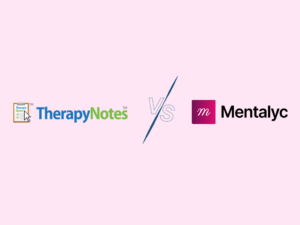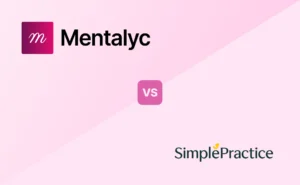The Diagnostic and Statistical Manual of Mental Disorders (DSM) has a long history of revisions and is essential to a mental health professional’s work. If you’re a mental health provider, you most likely work from the DSM-5, one of the more recent manual versions.
The DSM-5 (Diagnostic and Statistical Manual of Mental Disorders, Fifth Edition) is the standard reference used for diagnosing mental disorders, including ADHD (Attention-Deficit/Hyperactivity Disorder).
An even newer version called the Diagnostic and Statistical Manual of Mental Disorders Version 5 Text Revision (DSM-5-TR) has been available since 2022.
The DSM-5 made many updates in the classification of Attention-Deficit Hyperactivity Disorder (ADHD) from the earlier version DSM-IV. If you’re a clinician who works with clients who have or potentially have ADHD, being aware of the changes in the most recent versions of the DSM can help you diagnose and treat ADHD more accurately.

New! Transfer your notes to EHR with a single click. No more copy-pasting.
There were seven changes from the DSM-IV to the DSM-5. The DSM-5-TR did not update any of the diagnostic criteria for ADHD. The seven changes help clarify ADHD symptomology so clinicians can understand the disorder’s presentation more accurately. The added examples help individuals recognize symptoms they might be experiencing and can help clinicians tailor assessments for ADHD based on the criteria.
This article breaks down of the key criteria for ADHD in the DSM-5.
A Brief History of ADHD Classification in the DSM
Attention Deficit Hyperactivity Disorder (ADHD) classification in the DSM has changed significantly over the years. According to a 2013 article published in Neuropsychiatry, the ADHD diagnosis first appeared in the DSM-II and was called Hyperkinetic Reaction of Childhood and focused heavily on motor activity.
In the DSM-III, it was renamed Attention Deficit Disorder with or without hyperactivity and shifted more towards targeting problems with attention, concentration, and focus. The revised version of the DSM-III in the 1980s is where the term Attention-Deficit Hyperactivity Disorder (ADHD) first appeared.
The DSM-IV added three subtypes of ADHD: inattentive, hyperactive-impulsive, and combined. The DSM-5 made several updates to the criteria for diagnosis of ADHD. These changes were made to capture the symptomology present in individuals with ADHD more accurately.
What’s new in the DSM-5?
The DSM-5 made many changes to the symptom criteria for those with ADHD. These changes made it easier to classify and diagnose ADHD throughout the lifespan. While previous versions of the DSM stated this disorder mainly occurred and was diagnosed in childhood, researchers now know that many adults also deal with ADHD.
Classification of ADHD
The first significant change that was made in the DSM-5 was removing ADHD from the category of disorders that occur in infancy, childhood, and adolescence and moved it to the category of Neurodevelopmental Disorders section.
This change helps account for ADHD diagnosis across the lifespan, and not just in childhood, as many individuals don’t get diagnosed until later in life.
Added Examples for each Criteria
The criteria for ADHD are the same from the DSM-IV to the DSM-5; however, in the DSM-5, the second significant change adds examples to each of the requirements, for example:
One of the criteria from the DSM-IV states:
“Frequently struggles to maintain focus on tasks or during play activities.”
The DSM-5 takes it a step further by stating:
“Often has difficulty sustaining attention in tasks or play activities (e.g., has difficulty remaining focused during lectures, conversations, or lengthy reading).”
The added examples help clarify the situations included in the criteria.
Classification from “Some” symptoms to “Several”
Another change from the DSM-IV to the DSM-5 was classifying “some” symptoms of hyperactivity, impulsivity, and inattention to “several” symptoms. The shift from “some” to “several” helps change how symptoms of ADHD are diagnosed across different settings such as school, work, or home.
Age of Onset
The DSM-5 changed the age at which symptoms were first noticeable. The DSM-IV criteria often state that symptoms must’ve been present before age 7. The DSM-5 changed this to symptoms that were present before age 12.
Changes in the Subtypes
The DSM-5 has also upgraded the language regarding the subtypes of ADHD. The ADHD subtypes include:
· Inattentive presentation
· Hyperactive/Impulsive presentation
· Combined presentation
The DSM-IV splits the different criteria into A1 and A2 for the subtypes. The DSM-5 has more specific language, such as:
“Predominantly inattentive presentation: If enough symptoms of inattention but not hyperactivity/impulsivity were present for the past six months.”
This specificity can help clinicians diagnose ADHD subtypes more easily without referring to the A1 and A2 criteria.
Comorbid Diagnosis with Autism Spectrum Disorder
The DSM-IV didn’t include ADHD to be diagnosed with Autism Spectrum Disorder (ASD). The DSM-V criteria changed, allowing a comorbid diagnosis of ADHD and ASD. The two often have overlapping symptoms and can be diagnosed together.
Research from 2022 suggests that when Autism Spectrum Disorder is present in an individual, about 50-70% of the time, there is also comorbid ADHD. The growing literature in this area may account for the updated comorbid diagnosis in the DSM-5, as the literature continues to note a significant overlap.
Symptom Threshold Changes
For adult ADHD, the DSM-5 requires five symptoms to be met to qualify for a diagnosis of ADHD. The previous version of the DSM needed six symptoms to be present to meet the criteria for ADHD. The five symptoms across both subtypes are necessary to diagnose ADHD.
Were any changes made to ADHD in the DSM-5-TR?
The DSM-5-TR was a text revision edition that came out in March of 2022 that updated criteria for many mental health disorders. There were no changes made to ADHD criteria from the DSM-5 to the DSM-5-TR.
ADHD remains classified as a neurodevelopmental disorder that is characterized by inattention, hyperactivity, and impulsivity.
How do I find the ADHD classification in the DSM-5?
In the DSM-5-TR, you can find the ADHD classification under the Neurodevelopmental Disorders section. If you’re a clinician who references the DSM-5 often, you can buy tabs to mark each section of the DSM-5 so you can quickly flip to the section of the DSM-5 that you need.
More specifically, you can find the ADHD on page 59 of the DSM-5. If you’re a clinician who works with ADHD, this may help you find it easier in the DSM-5 in the future.
Overview of Changes in the DSM-5
The Diagnostic and Statistical Manual has had several revisions over the years and is published by the American Psychiatric Association. The most recent version of the DSM is the DSM-5-TR. The DSM-5 established new criteria for ADHD that make it more inclusive of symptoms and provide examples of what ADHD may look like.
There were seven total changes made from the DSM-IV to the DSM-5. These changes help clinicians better classify and diagnose the symptoms of ADHD. The revised symptoms with examples make it clear what symptoms of ADHD could look like.
If you’re a mental health professional who treats clients with ADHD, it’s important to understand the symptoms of ADHD. Some people deal with symptoms beyond what’s listed in the DSM-5, and they can cause a client significant distress.
Understanding the clinical criteria for ADHD is one piece of the puzzle. Obtaining continuing education in ADHD and having a clearer picture of the presentation of this disorder can help you grow and engage in better treatment modalities with your clients.
Resources:
- Substance Abuse and Mental Health Services Administration. (2016). DSM-5 Changes: Implications for Child Serious Emotional Disturbance. https://www.ncbi.nlm.nih.gov/books/NBK519712/table/ch3.t3/
- American Psychiatric Association. (2022). Attention Deficit Hyperactivity Disorder. In Diagnostic and Statistical Manual of Mental Disorders. (5th ed., text rev.).
- American Psychiatric Association (2013). Highlights of Changes from DSM-IV-TR to DSM-5. https://www.psychiatry.org/File%20Library/Psychiatrists/Practice/DSM/APA_DSM_Changes_from_DSM-IV-TR_-to_DSM-5.pdf
- Epstein J. & Loren R. (2013, October 1). Changes in the Definition of ADHD in the DSM-5: Subtle but Important. Neuropsychiatry. https://www.ncbi.nlm.nih.gov/pmc/articles/PMC3955126/
- Hours, C et al. (2022, February 28). ASD and ADHD Comorbidity: What Are We Talking About? https://www.ncbi.nlm.nih.gov/pmc/articles/PMC8918663/
- Magnus, W. et al. (2023, August 8). Attention Deficit Hyperactivity Disorder. Stat Pearls. https://www.ncbi.nlm.nih.gov/books/NBK441838/
- Stibbe, T. et al. (2020, October 15). Gender differences in adult ADHD: Cognitive function assessed by the test of attentional performance. PLoS One. https://www.ncbi.nlm.nih.gov/pmc/articles/PMC7561166/
Why other mental health professionals love Mentalyc

“It takes me less than 5 minutes to complete notes … it’s a huge time saver, a huge stress reliever.”
Licensed Marriage and Family Therapist

“By the end of the day, usually by the end of the session, I have my documentation done. I have a thorough, comprehensive note … It’s just saving me hours every week.”
CDCII

“Having Mentalyc take away some of the work from me has allowed me to be more present when I’m in session with clients … it took a lot of pressure off.”
LPC

“It’s so quick and easy to do notes now … I used to stay late two hours to finish my notes. Now it’s a breeze.”
Licensed Professional Counselor






